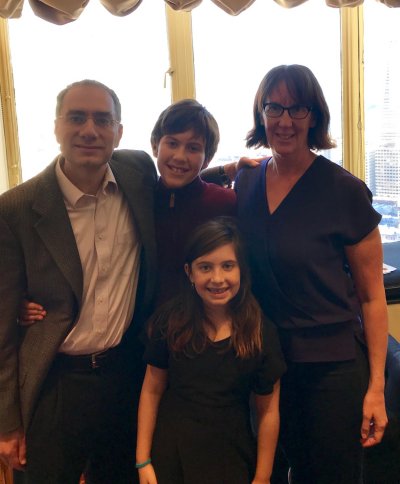ROOT: Your first book, The Complete Idiot’s Guide to Chess, is in its third edition. What comparisons can you make between it and your forthcoming book Learn to Play Chess Like a Boss: Make Pawns of Your Opponents with Tips and Tricks From a Grandmaster of the Game?
WOLFF: The "Learn to Play Chess Like a Boss" book is basically a rebranding and updating of the "Complete Idiot’s Guide to Chess" book.
Each new edition I update the book and add new material. The last chapter in particular – the one that covers computers and chess – is the product of a lot of effort on my part. After AlphaZero burst onto the scene, I spent a few months teaching myself about artificial intelligence, and I synthesized all of that knowledge for the reader. If you want to understand how AI works and how "traditional" versus "AI" computers play chess differently, this chapter is for you!
ROOT: GM Vishy Anand (World Champion 2007 – 2013) said, "ChessBase has changed the chess world forever. It is more or less unthinkable now not to work with it." How did you use ChessBase as Anand’s second in 1995? And how did you use ChessBase when writing Kasparov versus Anand: The Inside Story of the 1995 World Chess Championship?
WOLFF: We used ChessBase religiously during that match! And of course I used ChessBase in 1995 to enter all of my games and all of the games of the World Championship, and to research all the openings, and – well, really for everything. I completely agree with Anand that ChessBase revolutionized chess. If you read some of the analysis that I did in that book, you will see how it would have been impossible without ChessBase.
On this DVD a team of experts gets to the bottom of Kasparov's play. In over 8 hours of video running time the authors Rogozenko, Marin, Reeh and Müller cast light on four important aspects of Kasparov's play: opening, strategy, tactics and endgame.
Just to take one example, Game Three (which is a game that has unfortunately been largely forgotten because Anand missed his chance to win brilliantly) has a very deep analysis of moves 18 and 19 that I think really got all the way down to the bottom of the position, and this depth of analysis could not have been done without using ChessBase to organize all the variations. For you Sicilian geeks out there, this was the game that demonstrated that after 1.e4 c5 2.Nf3 d6 3.d4 cxd4 4.Nxd4 Nf6 5.Nc3 a6 6.Be2 e6 7.O-O Be7 8.a4 Nc6 9.Be3 0-0 10.f4 Qc7 11.Kh1 Re8 12.Bd3!? Nb4 13.a5 Bd7 14.Nf3!? the correct move is 14…Rac8, and 14…Bc6? is inaccurate due to 15.Bb6! Qc8 16.Qe1 Nd7 17.Bd4 Nc5 18.Qg3.
The first DVD with videos from Anand's chess career reflects the very beginning of that career and goes as far as 1999. It starts with his memories of how he first learned chess and shows his first great games (including those from the 1984 WCh for juniors). The high point of his early developmental phase was the winning of the 1987 WCh for juniors. After that, things continue in quick succession: the first victories over Kasparov, WCh candidate in both the FIDE and PCA cycles and the high point of the WCh match against Kasparov in 1995.
Running time: 3:48 hours
ROOT: You won the U.S. Championship twice, in 1992 and 1995. What was your favorite game from those two years, and why?
WOLFF: This may seem like a funny choice, but my favorite game from those two tournaments is my win with Black against Khmelnitsky in the 1995 U.S. Championship. It was a very dry opening, from which I got a small edge in the endgame, where I managed to squeeze out a win.
My other favorite game was my 1992 win with Black against Alexander Ivanov where I played the Caro-Kann for the first and only time in my life! That was after I had worked with Anand in 1992 helping him prepare for his match against Ivanchuk, and my time with him made me much more creative and adventurous. The previous round I had played White against Seirawan, who easily equalized against me with the Caro-Kann, so I decided to try the same thing against Ivanov. But Ivanov played a completely different variation and so I was thrown on my own devices! I found a way to complicate the position, and even though objectively I was losing it threw him into time trouble, and then I managed to confuse him and take the point. Not a game that would make anyone’s "Best Games" anthology, but a good struggle and a nice demonstration of how working with a super-genius can rub off!
ROOT: In 1996, you gave an interview to Dr. Christopher Chabris where you mentioned the need for chess to "attract Western corporate sponsors." Since then, you gave blindfold chess simultaneous exhibitions at Warren Buffett’s Berkshire Hathaway annual meetings. PayPal founder Peter Thiel, who has been rated over 2300 by US Chess, was instrumental in your career, as you worked as a portfolio manager in his Clarium Capital and he provided $50 million in seed money for your Grandmaster Capital. How can chess sponsorship be made attractive to tycoons such as Buffett and Thiel?
WOLFF: I am actually working on a project right now to try to adapt chess to make it more appealing for corporate sponsors, so stay tuned! The key, in my opinion, is to develop a format that creates suspense in chess that is understandable to anyone – not just someone who has studied chess for months and years.
ROOT: Until June 14, you had been serving as Interim Director at the Mechanics’ Institute Chess Room in San Francisco. What are your future plans in chess?
WOLFF: Well, let’s see how the project I alluded to above works out… As for the Mechanics’ Institute, I have been on the Board of Trustees for two and a half years and there was a need for someone to run the organization for a few months while we searched for a new Executive Director. I have enjoyed my time there and I am happy to have been able to make some positive changes there. I’m extremely excited about the new Executive Director, Kimberly Scrafano, who will start in early July. I’m also really excited about how the growth in the Chess Department at the Mechanics’ Institute. Watch us over the coming months and years to see our progress!
ROOT: Tell why the annual Harvard-Yale intercollegiate chess match is named the Wolff Cup and about your experience combining college and chess. What college advice and career advice would you give to 16-22 year old chess masters?
WOLFF: Naming it the Wolff Cup comes from my friend Christopher Chabris, who organized several chess events at Harvard and managed to convince Harvard and Yale, since I had gone to college at both places. I matriculated at Yale in 1987 and then left in 1989 when I won the Samford Chess Fellowship. Since I was living in Boston when I went back to school to complete my undergraduate education in 1994, I transferred to Harvard. I’m one of the few people I know who went to both Yale and Harvard as an undergraduate! It was very nice and I’m honored by it.
As for my experience combining college and chess… Well, when I first went to Yale as a freshman in 1987, I knew in the back of my head that I was likely to win the Samford and would probably play chess professionally. I had the bug at that point and needed to get it out of my system. So my two years at Yale were a lot of fun and I made some of the best friends of my life during that time, but I was always somewhat distracted. When I went back to school in 1994, it was different: while I was still very much a serious chess player – during my time at Harvard I took a semester off to be Anand’s second in the 1995 World Championship match, to write a book about that World Championship, and then to play in and win the 1995 US Championship! – I was much more focused on my studies because I was in transition away from chess and towards whatever my next career would be, which turned out to be business and investing.
Advice for the aspiring young chess master…? To be honest, I think what specific decisions are best depends on the specific circumstances of the person, so I don’t think I have any "general advice" in that regard to offer. I do not believe there are any "best careers" for chess players, nor do I believe chess players are "good at this" or "not good at that." I think you should feed your curiosity, learn constantly, be ambitious, and be true to your values and your passions. All of that is pretty general advice, but that’s okay – I don’t think there is anything so special or different about chess players compared to all the rest of humanity!
ROOT: What other projects or plans do you have for the next five years?
WOLFF: On the professional side I’m exploring a few things at this point and I’m not yet sure which direction I will go in. Check back with me in six months! It might even have something to do with chess… On the personal side, I am blessed to be happily married and have two wonderful children so I just hope they will continue to thrive. We are looking forward to taking a vacation this summer in Italy and Greece. Our 13 year old son, Samuel, planned a lot of our activities in Italy, and our 10 year old daughter, Athena, is looking forward to visiting Athens!

Patrick Wolff and his family | Photo: Courtesy of Patrick Wolff
























